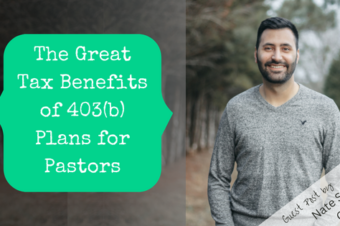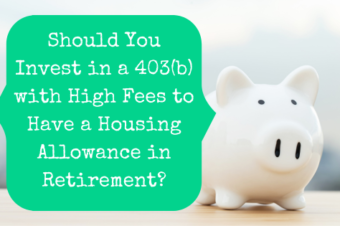
As we’ve discussed previously, churches are not required to withhold taxes for pastors and other clergy. Because of a minister’s dual taxation status, the IRS expects them to pay as if they were self-employed.
How do self-employed people pay taxes?
Through quarterly estimated tax payments. So, as a pastor, you’re required to make quarterly estimated tax payments.
What Are Quarterly Estimated Tax Payments?
Our American tax system is a pay-as-you-go system. Many people don’t realize this because they think they only pay once a year- on April 15. However, most employees are paying all year long, out of every paycheck. The yearly tax return they file is just to check their balance for over- or under-payments.
The IRS doesn’t want to wait a year to get their money. They want it immediately, which is why most employees are subject to mandatory tax withholding. Self-employed people, though, don’t have an employer to withhold their taxes for them. And many of them do not pay themselves a regular paycheck from which taxes could be withheld. Therefore, the IRS set up the quarterly estimated tax payment system.
Self-employed people (or those treated as if self-employed, like clergy) are required to pay taxes four times a year with IRS Form 1040-ES. These payments include federal income tax and SECA taxes, which are the Social Security and Medicare taxes.
When Are Quarterly Estimated Tax Payments Due?
While quarterly payments are due four times a year, the year is not divided up equally. This is when each payment is due and what each payment covers:

If the due date falls on a weekend or holiday, it gets pushed back to the next business day. For example, this September 15 is a Sunday, so the payment is due the next day, Monday, September 16, 2019.
How Should Pastors Calculate Quarterly Estimated Tax Payments?
IRS Form 1040-ES includes a worksheet for calculating estimated payments. However, it gets complicated. Use that if you want something comprehensive and exact. Otherwise, I will explain the basics of calculating your estimated payments.
Calculating Estimated Income Tax Payments
I’ll start by addressing income taxes, because that applies to all pastors, whether or not you’ve opted out of Social Security. If you’ve opted out, this is all you have to worry about. If not, you need to read the next section as well.
The basic way to figure estimated taxes is to take your expected salary and subtract expected deductions (standard or itemized, plus half of SECA taxes due) to find your expected taxable income.
Expected Salary – Expected Deductions = Expected Taxable Income
Then look up the tax on that expected taxable income in the 2019 tax rate schedules below (taken from IRS Form 1040-ES).

That is your expected annual tax. You can lower it by any tax credits you expect to receive, such as the child tax credit. Once you’ve accounted for credits, you can just divide it so that it represents the quarter you are paying. This month’s estimated payment covers 3 months (June, July, and August), so the equation would look like this:
Estimated Annual Tax (Less Expected Tax Credits) * 3/12 = Quarterly Tax Payment Due
If you have irregular income, you should look back at just the months in question. Take your income from those months, subtract the time period’s portion of your expected annual deduction (for example, 3/12 of the standard deduction), and use that amount to figure your tax for the quarter.
Remember that your housing allowance is exempt from federal income taxation, so it should not be included in these calculations!
Pastors Participating In Social Security
If you chose to remain in the Social Security system, then you have to pay SECA taxes on top of your income taxes. Remember that your housing allowance is not exempt from SECA taxes, so you will need to include it in your total income. If you live in a parsonage, you also have to include the fair market rental value of the parsonage in your total income.
If you earn under $132,900, then your SECA taxes are 15.3% of 92.35% of your income. For this September’s payment, you would calculate it as:
Income (including housing or parsonage allowance) * 0.9235 * 0.153 = Annual SECA Taxes
Annual SECA Taxes * 3/12 = SECA Taxes Due This Quarter
If your total income exceeds $132,900, then you SECA taxes are 15.3% of 92.35% income up to that amount plus 2.9% above that amount.
Your quarterly estimated tax payment is comprised of both your estimated income taxes due and SECA taxes.
How To Avoid Penalties
If you don’t pay your estimated taxes, you will be penalized by the IRS. You can also incur penalties if you underpay. Sometimes it can be hard to estimate taxes, so the IRS created “safe harbor” calculations. If you use these calculations you will not be penalized, even if you underpay. You should be safe from penalties if you:
- Expect to owe less than $1,000
- Pay 100% of your previous year’s tax liability if your adjusted gross income is under $150,000. If it is over that, you have to pay 110% of the previous year’s tax liability.
- Pay within 90% of your actual tax liability for the year
Another Way To Do It
Making quarterly estimated tax payments can be a real pain. If you don’t want to have to deal with this, ask your church to withhold taxes for you. While they aren’t required to, they are allowed to. They can’t pay your SECA taxes for you, but they can withhold enough to cover your SECA taxes at the end of the year.
Another way to avoid paying quarterly estimated taxes is by having another employer withhold more. If you or your spouse is an employee of a secular company that withholds taxes, just have them withhold enough to cover your pastoral income. Changing your withholdings is as simple as filling out a Form W-4 and filing it with the company’s Human Resource department.
I hope this sets you up for success this September 16 and in the future. If you have further questions, ask me in the comments or email me!




4 Responses
Jen
April 12, 2020Hi Amy,
My husband just became a worship pastor and I’m trying to make sense of everything tax related that comes with this change. I’m starting to understand the basics of the above info but am curious how his pastoral role affects filing the rest of our taxes. For the first few months of this year (2020) he was on staff at our church but not as a pastor. I also work as a nurse. Will we pay quarterly taxes for his pastoral role for the remainder of this year and then file taxes next Spring (2021) for the W-2’s we’ll both have from this year (his for the first few months and mine for my job)?
Amy
April 12, 2020Jen, all of your income, including his pastoral income, will be reported on your tax return next spring. When you file your return, you calculate how much your tax liability is for the year with your final income numbers and then compare it to what your employer withheld and then either pay or receive the difference. The quarterly estimated payments function the same way as the employer’s withholding for pastors whose employers don’t withhold any taxes. Then when they file their tax returns, they compare how much they sent in for quarterly estimated taxes with how much they calculated that they should have to pay and the difference is either their refund or what they owe. If you have any further questions, feel free to email me at amy@pastorswallet.com.
Bob Reid
February 15, 2023This is very helpful, exactly what I was looking for. I was just st wondering if my rough math would get me to the same destination. For example, I’ve been told that an average of 20% taxes are taken out of salaries. So a pastor who makes $60,000 would owe around $12,000 (60,000 x. 0.2). To account for the standard deduction, I divide that by 2. So that pastor would owe around $6,000 (about $1,500 per quarter). Is it okay to keep it that simple and still stay fulfill my obligations to the IRS?
Another question I have about this topic is that I also owe quarterly state taxes, so I normally take that $1,500 and I send 85% ($1,275) to federal and 15% (225) to the state. It’s been working out for me since I became a “1099” pastor about 4 years ago. I usually get a refund except last year when we got taxed on the covid relief funds so I had to pay, that my first time ever having to pay.
But generally speaking, am I asking for trouble in the long run with my rough math or do you think I can keep doing it since it seems to work out?
Amy
April 9, 2023There’s really no rule of thumb that works because everyone’s tax situation is so different. I would say that if the math you are using has been working for you, then it is probably good in your situation. The biggest risk is having to pay an IRS underpayment penalty. The penalty itself isn’t a lot so it’s not worth losing any sleep over. However, to avoid owing any penalty, you need to pay either 90% of the current tax year’s tax liability or 100% of the previous year’s. As long as you pay at least that much, you won’t owe an underpayment penalty.